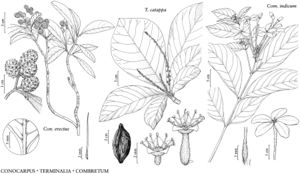Conocarpus erectus
Sp. Pl. 1: 176. 1753. (as erecta)
Shrubs or trees to 12 (–20) m, sometimes ± prostrate. Leaves: petiole 1.5–16 mm; blade elliptic to obovate, 1.5–10 × 0.5–4 [–5] cm, smaller in terminal inflorescences, base attenuate to cuneate, surfaces glabrous or sparsely to densely pubescent, hairs appressed to ± erect, straight to crisped/tangled, combretaceous, some also minute, glandular. Inflorescences racemes or panicles of spherical or oblong heads (appearing paniculate), branches reproductive 3–25 cm distally, axis of lateral inflorescence 1–10 cm, heads conelike, 4–9 × 4–8 mm. Flowers: sepals 0.4–0.8 mm; stamens 1.8–3.5 mm; style 1–1.8 mm. Drupes greenish or brown, 2.5–4.5 × 2.7–5.5 mm, pubescent distally; clusters 6–12 mm. 2n = 24.
Phenology: Flowering spring–fall.
Habitat: in coastal and tropical areas..
Elevation: 0–10 m.
Distribution
Fla., Tex., Mexico, West Indies, South America, w Africa, in coastal and tropical areas
Discussion
In Florida, Conocarpus erectus is distributed from the Keys northward along the Gulf Coast to Levy County and along the Atlantic Coast to Volusia County. It has recently been reported from Willacy County, Texas.
Conocarpus erectus is commonly present on the landward margins of mangrove communities, as a mangrove associate. Although salt tolerant, it lacks obvious biological specializations of the mangrove community (for example, it is not viviparous and does not show root modifications). It is also common in open wetland communities and in tropical hammocks (tree islands). The densely packed flowers likely are generalist-insect pollinated; the fruits float and are dispersed by water. Some plants are consistently and densely pubescent, others are consistently glabrous, and still others show intermediate conditions such as a few slightly pubescent leaves on an otherwise densely pubescent plant, a few sparsely pubescent leaves on an otherwise glabrous plant, and plants producing both pubescent and glabrous leaves in a cyclic pattern. The densely pubescent form, “silver-leaved buttonwood,” is a common ornamental in coastal regions, and its hairs give the leaves a gray to silver, occasionally even golden, coloration. Conocarpus erectus is extremely variable in stature; some plants form low-growing and almost prostrate shrubs, whereas others are erect trees.
Selected References
None.
